Genomic Sequencing and Characterization of Two Auricularia Species from the Qinling Region: Insights into Evolutionary Dynamics and Secondary Metabolite Potential
Abstract
1. Introduction
2. Materials and Methods
2.1. Fungal Material and Nucleic Acid Extraction
2.2. Genome Assembly and Chromosome Assembly
2.3. Genome Annotation
2.4. Comparative Genomic Analysis
2.5. Single-Nucleotide Polymorphism (SNP) Site Detection
2.6. Reconstruction of the Phylogenetic Tree
2.7. Analyses of Gene-Family Expansion and Contraction
2.8. CAZyme and P450 Analysis
2.9. Identification of Repetitive Elements and LTR Analysis
2.10. BGC Analysis and Visualization
2.11. Data Availability
3. Results
3.1. Resource Collection, Domestication, and Cultivation of Wild Auricularia Mushrooms in the Qinling Mountains
3.2. Genome Sequencing, De Novo Assembly, and Annotation
3.3. Comparative Genome Analysis Within Auricularia Species
3.4. Phylogenetic and Gene Family Variation Analysis
3.5. CAZyme Analysis and Developing SSR Markers
3.6. TE Analysis and Genome Duplication
3.7. Search and Analysis of Secondary Metabolite-Related Genes
4. Discussion
5. Conclusions
Supplementary Materials
Author Contributions
Funding
Institutional Review Board Statement
Informed Consent Statement
Data Availability Statement
Conflicts of Interest
References
- Wu, F.; Tohtirjap, A.; Fan, L.F.; Zhou, L.W.; Alvarenga, R.L.M.; Gibertoni, T.B.; Dai, Y.C. Global Diversity and Updated Phylogeny of Auricularia (Auriculariales, Basidiomycota). J. Fungi 2021, 7, 933. [Google Scholar] [CrossRef] [PubMed]
- Baldrian, P.; Lindahl, B. Decomposition in forest ecosystems: After decades of research still novel findings. Fungal Ecol. 2011, 4, 359–361. [Google Scholar] [CrossRef]
- Dai, Y.; Yang, Z. A revised checklist of medicinal fungi in China. Mycosystema 2008, 27, 801–824. [Google Scholar] [CrossRef]
- Dickson, J. Fasciculus Plantarum Cryptogamicarum Britanniae; G. Nicol: London, UK, 1785. [Google Scholar]
- Persoon, C.H. Mycologia Europaea; J.J. Palm: Los Angeles, CA, USA, 1822. [Google Scholar]
- Wu, F.; Yuan, Y.; Malysheva, V.; Du, P.; Dai, Y.C. Species clarification of the most important and cultivated Auricularia mushroom “Heimuer”: Evidence from morphological and molecular data. Phytotaxa 2014, 186, 241–253. [Google Scholar] [CrossRef]
- Looney, B.P.; Birkebak, J.M.; Matheny, P.B. Systematics of the genus Auricularia with an emphasis on species from the southeastern United States. N. Am. Fungi 2013, 8, 1–25. [Google Scholar] [CrossRef]
- Ye, L.; Huang, Y.; Zhang, B.; Luo, J.; Liu, H.; Yang, X.; Ma, S.; Chen, S.; Zhang, W.; Tan, W.; et al. Transcriptome profiling reveals postharvest quality losses of pink Auricularia cornea. Postharvest Biol. Technol. 2024, 215, 113020. [Google Scholar] [CrossRef]
- Ye, L.; Zhang, B.; Yang, X.; Huang, Y.; Luo, J.; Zhang, X.; Tan, W.; Song, C.; Ao, Z.; Shen, C.; et al. Metabolomic profiling reveals biomarkers for diverse flesh colors in jelly fungi (Auricularia cornea). Food Chem. 2024, 446, 138906. [Google Scholar] [CrossRef]
- Bandara, A.R.; Mortimer, P.E.; Vadthanarat, S.; Peng, X.; Karunarathna, S.C.; Hyde, K.D.; Kakumyan, P.; Xu, J. First successful domestication of a white strain of Auricularia cornea from Thailand. Stud. Fungi 2020, 5, 420–434. [Google Scholar] [CrossRef]
- Victor, S.E.; Clementina, O.A.; Omena, B.O.; Peter, M.E. Spatial and regional directory of wild Auricularia species found in the forest of Southwest Nigeria. Afr. J. Biotechnol. 2021, 20, 398–415. [Google Scholar] [CrossRef]
- Zhang, J.; Chen, Q.; Huang, C.; Gao, W.; Qu, J. History, current situation and trend of edible mushroom industry development. Mycosystema 2015, 34, 524–540. [Google Scholar] [CrossRef]
- Shi, Y.; Xin, X.; Zhang, C.; Li, A. Effects of Auricularia auricula Underw polysaccharide on sport capacity of living organism. Chin. J. Clin. Rehabil. 2006, 10, 106–108. [Google Scholar]
- Cai, M.; Lin, Y.; Luo, Y.; Liang, H.H.; Sun, P. Extraction, Antimicrobial, and Antioxidant Activities of Crude Polysaccharides from the Wood Ear Medicinal Mushroom Auricularia auricula-judae (Higher Basidiomycetes). Int. J. Med. Mushrooms 2015, 17, 591–600. [Google Scholar] [CrossRef]
- Yuan, Z.M.; He, P.M.; Cui, J.H.; Takeuchi, H. Hypoglycemic effect of water-soluble polysaccharide from Auricularia auricula-judae Quel. on genetically diabetic KK-Ay mice. Biosci. Biotechnol. Biochem. 1998, 62, 1898–1903. [Google Scholar] [CrossRef][Green Version]
- Zhou, Y.; Jia, Y.; Xu, N.; Tang, L.; Chang, Y. Auricularia auricula-judae (Bull.) polysaccharides improve obesity in mice by regulating gut microbiota and TLR4/JNK signaling pathway. Int. J. Biol. Macromol. 2023, 250, 126172. [Google Scholar] [CrossRef]
- Shi, Q.; Li, X.; He, J.; Ye, D.; Tang, H.; Xuan, J.; Tang, Y.; Zhang, Y.; Zhang, Y. Effects of Auricularia auricula-judae (Bull.) Quél. polysaccharide acid hydrolysate on glucose metabolism in diabetic mice under oxidative stress. Phytomedicine 2024, 128, 155485. [Google Scholar] [CrossRef]
- Zong, X.; Zhang, H.; Zhu, L.; Deehan, E.C.; Fu, J.; Wang, Y.; Jin, M. Auricularia auricula polysaccharides attenuate obesity in mice through gut commensal Papillibacter cinnamivorans. J. Adv. Res. 2023, 52, 203–218. [Google Scholar] [CrossRef]
- Zhao, S.; Rong, C.; Liu, Y.; Xu, F.; Wang, S.; Duan, C.; Chen, J.; Wu, X. Extraction of a soluble polysaccharide from Auricularia polytricha and evaluation of its anti-hypercholesterolemic effect in rats. Carbohydr. Polym. 2015, 122, 39–45. [Google Scholar] [CrossRef]
- Floudas, D.; Binder, M.; Riley, R.; Barry, K.; Blanchette, R.A.; Henrissat, B.; Martínez, A.T.; Otillar, R.; Spatafora, J.W.; Yadav, J.S.; et al. The Paleozoic Origin of Enzymatic Lignin Decomposition Reconstructed from 31 Fungal Genomes. Science 2012, 336, 1715–1719. [Google Scholar] [CrossRef]
- Yuan, Y.; Wu, F.; Si, J.; Zhao, Y.F.; Dai, Y.C. Whole genome sequence of Auricularia heimuer (Basidiomycota, Fungi), the third most important cultivated mushroom worldwide. Genomics 2019, 111, 50–58. [Google Scholar] [CrossRef]
- Ye, L.; Zhang, L.; Li, X.; Huang, Y.; Zhang, B.; Yang, X.; Tan, W.; Li, X.; Zhang, X. De novo genome assembly and functional insights of the first commercial pink Auricularia cornea. Genomics 2024, 116, 110902. [Google Scholar] [CrossRef]
- Ranallo-Benavidez, T.R.; Jaron, K.S.; Schatz, M.C. GenomeScope 2.0 and Smudgeplot for reference-free profiling of polyploid genomes. Nat. Commun. 2020, 11, 1432. [Google Scholar] [CrossRef] [PubMed]
- Chen, Y.; Nie, F.; Xie, S.Q.; Zheng, Y.F.; Dai, Q.; Bray, T.; Wang, Y.X.; Xing, J.F.; Huang, Z.J.; Wang, D.P.; et al. Efficient assembly of nanopore reads via highly accurate and intact error correction. Nat. Commun. 2021, 12, 60. [Google Scholar] [CrossRef] [PubMed]
- Walker, B.J.; Abeel, T.; Shea, T.; Priest, M.; Abouelliel, A.; Sakthikumar, S.; Cuomo, C.A.; Zeng, Q.; Wortman, J.; Young, S.K.; et al. Pilon: An integrated tool for comprehensive microbial variant detection and genome assembly improvement. PLoS ONE 2014, 9, e112963. [Google Scholar] [CrossRef]
- Parra, G.; Bradnam, K.; Korf, I. CEGMA: A pipeline to accurately annotate core genes in eukaryotic genomes. Bioinformatics 2007, 23, 1061–1067. [Google Scholar] [CrossRef]
- Huang, N.; Li, H. Compleasm: A faster and more accurate reimplementation of BUSCO. Bioinformatics 2023, 39, btad595. [Google Scholar] [CrossRef]
- Zhang, X.; Zhang, S.; Zhao, Q.; Ming, R.; Tang, H. Assembly of allele-aware, chromosomal-scale autopolyploid genomes based on Hi-C data. Nat. Plants 2019, 5, 833–845. [Google Scholar] [CrossRef]
- Li, H.; Durbin, R. Fast and accurate long-read alignment with Burrows-Wheeler transform. Bioinformatics 2010, 26, 589–595. [Google Scholar] [CrossRef]
- Servant, N.; Varoquaux, N.; Lajoie, B.R.; Viara, E.; Chen, C.J.; Vert, J.P.; Heard, E.; Dekker, J.; Barillot, E. HiC-Pro: An optimized and flexible pipeline for Hi-C data processing. Genome Biol. 2015, 16, 259. [Google Scholar] [CrossRef]
- Burton, J.N.; Adey, A.; Patwardhan, R.P.; Qiu, R.; Kitzman, J.O.; Shendure, J. Chromosome-scale scaffolding of de novo genome assemblies based on chromatin interactions. Nat. Biotechnol. 2013, 31, 1119–1125. [Google Scholar] [CrossRef]
- Nachtweide, S.; Stanke, M. Multi-Genome Annotation with AUGUSTUS. Methods Mol. Biol. 2019, 1962, 139–160. [Google Scholar] [CrossRef]
- Nawrocki, E.P.; Eddy, S.R. Infernal 1.1: 100-fold faster RNA homology searches. Bioinformatics 2013, 29, 2933–2935. [Google Scholar] [CrossRef] [PubMed]
- Drula, E.; Garron, M.L.; Dogan, S.; Lombard, V.; Henrissat, B.; Terrapon, N. The carbohydrate-active enzyme database: Functions and literature. Nucleic Acids Res. 2021, 50, D571–D577. [Google Scholar] [CrossRef]
- Zhang, Z.; Wood, W.I. A profile hidden Markov model for signal peptides generated by HMMER. Bioinformatics 2003, 19, 307–308. [Google Scholar] [CrossRef]
- Wang, Y.; Tang, H.; Debarry, J.D.; Tan, X.; Li, J.; Wang, X.; Lee, T.H.; Jin, H.; Marler, B.; Guo, H.; et al. MCScanX: A toolkit for detection and evolutionary analysis of gene synteny and collinearity. Nucleic Acids Res. 2012, 40, e49. [Google Scholar] [CrossRef]
- Bandi, V.; Gutwin, C.; Siri, J.N.; Neufeld, E.; Sharpe, A.; Parkin, I. Visualization Tools for Genomic Conservation. In Plant Bioinformatics: Methods and Protocols; Edwards, D., Ed.; Springer: New York, NY, USA, 2022; pp. 285–308. [Google Scholar]
- Wu, T.; Hu, E.; Xu, S.; Chen, M.; Guo, P.; Dai, Z.; Feng, T.; Zhou, L.; Tang, W.; Zhan, L.; et al. Clusterprofiler 4.0: A universal enrichment tool for interpreting omics data. Innovation 2021, 2, 100141. [Google Scholar] [CrossRef]
- Li, H. Aligning sequence reads, clone sequences and assembly contigs with BWA-MEM. arXiv 2013, arXiv:1603.00278. [Google Scholar] [CrossRef]
- Heldenbrand, J.R.; Baheti, S.; Bockol, M.; Drucker, T.M.; Hart, S.N.; Hudson, M.E.; Iyer, R.K.; Kalmbach, M.T.; Klee, E.W.; Wieben, E.D.; et al. Performance benchmarking of GATK3.8 and GATK4. Biorxiv 2018, 348565. [Google Scholar] [CrossRef]
- Chang, C.C.; Chow, C.C.; Tellier, L.C.; Vattikuti, S.; Purcell, S.M.; Lee, J.J. Second-generation PLINK: Rising to the challenge of larger and richer datasets. Gigascience 2015, 4, 7. [Google Scholar] [CrossRef]
- Emms, D.M.; Kelly, S. OrthoFinder: Phylogenetic orthology inference for comparative genomics. Genome Biol. 2019, 20, 238. [Google Scholar] [CrossRef]
- Katoh, K.; Standley, D.M. MAFFT multiple sequence alignment software version 7: Improvements in performance and usability. Mol. Biol. Evol. 2013, 30, 772–780. [Google Scholar] [CrossRef]
- Minh, B.Q.; Schmidt, H.A.; Chernomor, O.; Schrempf, D.; Woodhams, M.D.; von Haeseler, A.; Lanfear, R. IQ-TREE 2: New Models and Efficient Methods for Phylogenetic Inference in the Genomic Era. Mol. Biol. Evol. 2020, 37, 1530–1534. [Google Scholar] [CrossRef] [PubMed]
- Yang, Z. PAML 4: Phylogenetic Analysis by Maximum Likelihood. Mol. Biol. Evol. 2007, 24, 1586–1591. [Google Scholar] [CrossRef] [PubMed]
- Kumar, S.; Suleski, M.; Craig, J.M.; Kasprowicz, A.E.; Sanderford, M.; Li, M.; Stecher, G.; Hedges, S.B. TimeTree 5: An Expanded Resource for Species Divergence Times. Mol. Biol. Evol. 2022, 39, msac174. [Google Scholar] [CrossRef]
- Mendes, F.K.; Vanderpool, D.; Fulton, B.; Hahn, M.W. CAFE 5 models variation in evolutionary rates among gene families. Bioinformatics 2020, 36, 5516–5518. [Google Scholar] [CrossRef]
- Letunic, I.; Bork, P. Interactive Tree of Life (iTOL) v6: Recent updates to the phylogenetic tree display and annotation tool. Nucleic Acids Res. 2024, 52, W78–W82. [Google Scholar] [CrossRef]
- Tarailo-Graovac, M.; Chen, N. Using RepeatMasker to Identify Repetitive Elements in Genomic Sequences. Curr. Protoc. Bioinform. 2009, 25, 4–10. [Google Scholar] [CrossRef]
- Flynn, J.M.; Hubley, R.; Goubert, C.; Rosen, J.; Clark, A.G.; Feschotte, C.; Smit, A.F. RepeatModeler2 for automated genomic discovery of transposable element families. Proc. Natl. Acad. Sci. USA 2020, 117, 9451–9457. [Google Scholar] [CrossRef]
- Benson, G. Tandem repeats finder: A program to analyze DNA sequences. Nucleic Acids Res. 1999, 27, 573–580. [Google Scholar] [CrossRef]
- Bao, Z.; Eddy, S.R. Automated de novo identification of repeat sequence families in sequenced genomes. Genome Res. 2002, 12, 1269–1276. [Google Scholar] [CrossRef]
- Storer, J.; Hubley, R.; Rosen, J.; Wheeler, T.J.; Smit, A.F. The Dfam community resource of transposable element families, sequence models, and genome annotations. Mob. DNA 2021, 12, 2. [Google Scholar] [CrossRef]
- Ellinghaus, D.; Kurtz, S.; Willhoeft, U. LTRharvest, an efficient and flexible software for de novo detection of LTR retrotransposons. BMC Bioinf. 2008, 9, 18. [Google Scholar] [CrossRef] [PubMed]
- Katoh, K.; Misawa, K.; Kuma, K.; Miyata, T. MAFFT: A novel method for rapid multiple sequence alignment based on fast Fourier transform. Nucleic Acids Res. 2002, 30, 3059–3066. [Google Scholar] [CrossRef]
- Rice, P.; Longden, I.; Bleasby, A. EMBOSS: The European Molecular Biology Open Software Suite. Trends Genet. 2000, 16, 276–277. [Google Scholar] [CrossRef]
- Blin, K.; Shaw, S.; Augustijn, H.E.; Reitz, Z.L.; Biermann, F.; Alanjary, M.; Fetter, A.; Terlouw, B.R.; Metcalf, W.W.; Helfrich, E.J.N.; et al. antiSMASH 7.0: New and improved predictions for detection, regulation, chemical structures and visualisation. Nucleic Acids Res. 2023, 51, W46–W50. [Google Scholar] [CrossRef]
- Gilchrist, C.L.M.; Chooi, Y.H. Synthaser: A CD-Search enabled Python toolkit for analysing domain architecture of fungal secondary metabolite megasynth(et)ases. Fungal Biol. Biotechnol. 2021, 8, 13. [Google Scholar] [CrossRef]
- Duan, K.; Chen, M. Development Status and Countermeasures of Auricularia Industry in Zhashui County of Shaanxi Province. Agric. Eng. 2022, 12, 158–160. [Google Scholar] [CrossRef]
- Ma, X.X.; Lu, L.X.; Yao, F.J.; Fang, M.; Wang, P.; Meng, J.J.; Shao, K.S.; Sun, X.; Zhang, Y.M. High-quality genome assembly and multi-omics analysis of pigment synthesis pathway in Auricularia cornea. Front. Microbiol. 2023, 14, 1211795. [Google Scholar] [CrossRef]
- Fang, M.; Wang, X.; Chen, Y.; Wang, P.; Lu, L.X.; Lu, J.; Yao, F.J.; Zhang, Y.M. Genome Sequence Analysis of Auricularia heimuer Combined with Genetic Linkage Map. J. Fungi 2020, 6, 37. [Google Scholar] [CrossRef]
- He, X.L.; Huo, W.Y.; Zhang, L.G.; Dai, L.; Qi, P.; Liu, Y.; Li, J.Z. A New Species of Hygrophoropsis (Boletales, Basidiomycota) from Qinling Mountains in China. J. Fungal Res. 2024, 22, 135–141. [Google Scholar] [CrossRef]
- He, X.L.; Huo, W.Y.; Zhang, L.G.; Dai, L.; Liu, Y.; Li, J.Z. Two New Species of Helvella (Pezizales, Ascomycota) Collected from the Qinling Mountains of China. J. Fungal Res. 2024, 22, 226–235. [Google Scholar] [CrossRef]
- Dong, W.G.; Wang, Z.X.; Feng, X.L.; Zhang, R.Q.; Shen, D.Y.; Du, S.; Gao, J.M.; Qi, J. Chromosome-Level Genome Sequences, Comparative Genomic Analyses, and Secondary-Metabolite Biosynthesis Evaluation of the Medicinal Edible Mushroom Laetiporus sulphureus. Microbiol. Spectr. 2022, 10, e0243922. [Google Scholar] [CrossRef] [PubMed]
- Song, Y.; Zhang, M.; Liu, Y.Y.; Li, M.; Xie, X.; Qi, J. Haplotype-Phased Chromosome-Level Genome Assembly of Cryptoporus qinlingensis, a Typical Traditional Chinese Medicine Fungus. J. Fungi 2025, 11, 163. [Google Scholar] [CrossRef] [PubMed]
- Xie, X.; Zhao, L.; Song, Y.; Qiao, Y.; Wang, Z.X.; Qi, J. Genome-wide characterization and metabolite profiling of Cyathus olla: Insights into the biosynthesis of medicinal compounds. BMC Genom. 2024, 25, 618. [Google Scholar] [CrossRef]
- Wei, J.; Cheng, M.; Zhu, J.F.; Zhang, Y.; Cui, K.; Wang, X.; Qi, J. Comparative Genomic Analysis and Metabolic Potential Profiling of a Novel Culinary-Medicinal Mushroom, Hericium rajendrae (Basidiomycota). J. Fungi 2023, 9, 1018. [Google Scholar] [CrossRef]
- Xie, X.; Chen, R.-X.; Song, Y.; Lin, C.; Zhang, M.; Li, M.; Qi, J. Trichaptum biforme (Pallidohirschioporus biformis) genome decoding provides insights into carbohydrate degradation and polysaccharide synthesis. Genomics 2025, 117, 111057. [Google Scholar] [CrossRef]
- Dai, Y.; Li, X.; Song, B.; Sun, L.; Yang, C.; Zhang, X.; Wang, Y.; Zhang, Z.; Fu, Y.; Li, Y. Genomic Analyses Provide Insights Into the Evolutionary History and Genetic Diversity of Auricularia Species. Front. Microbiol. 2019, 10, 2255. [Google Scholar] [CrossRef]
- Liu, J.; Zhang, B.; Wang, L.; Li, S.; Long, Q.; Xiao, X. Bioactive components, pharmacological properties and underlying mechanism of Ganoderma lucidum spore oil: A review. Chin. Herb. Med. 2024, 16, 375–391. [Google Scholar] [CrossRef]
- Peng, S.; Qi, J.; Lin, C.; Xu, Z.; Li, Z.; Liu, C. From natural laboratory to drug discovery: Chemical structures, bioactivities, and biosynthesis of meroterpenoids from Ganoderma species. Chin. Herb. Med. 2025, 17. [Google Scholar] [CrossRef]
- Liu, J.-X.; Cai, Q.-F.; Lin, X.-Z.; Gao, T.-T.; Luan, Y.-X. Research progress on active components, functional characteristics and applications of edible fungi. Food Med. Homol. 2025. [Google Scholar] [CrossRef]
- Wang, Z.-X.; Huang, K.; Pu, K.-L.; Li, L.; Jiang, W.-X.; Wu, J.; Kawagishi, H.; Li, M.; Qi, J. Naematelia aurantialba: A comprehensive review of its medicinal, nutritional, and cultivation aspects. Food Med. Homol. 2025. [Google Scholar] [CrossRef]
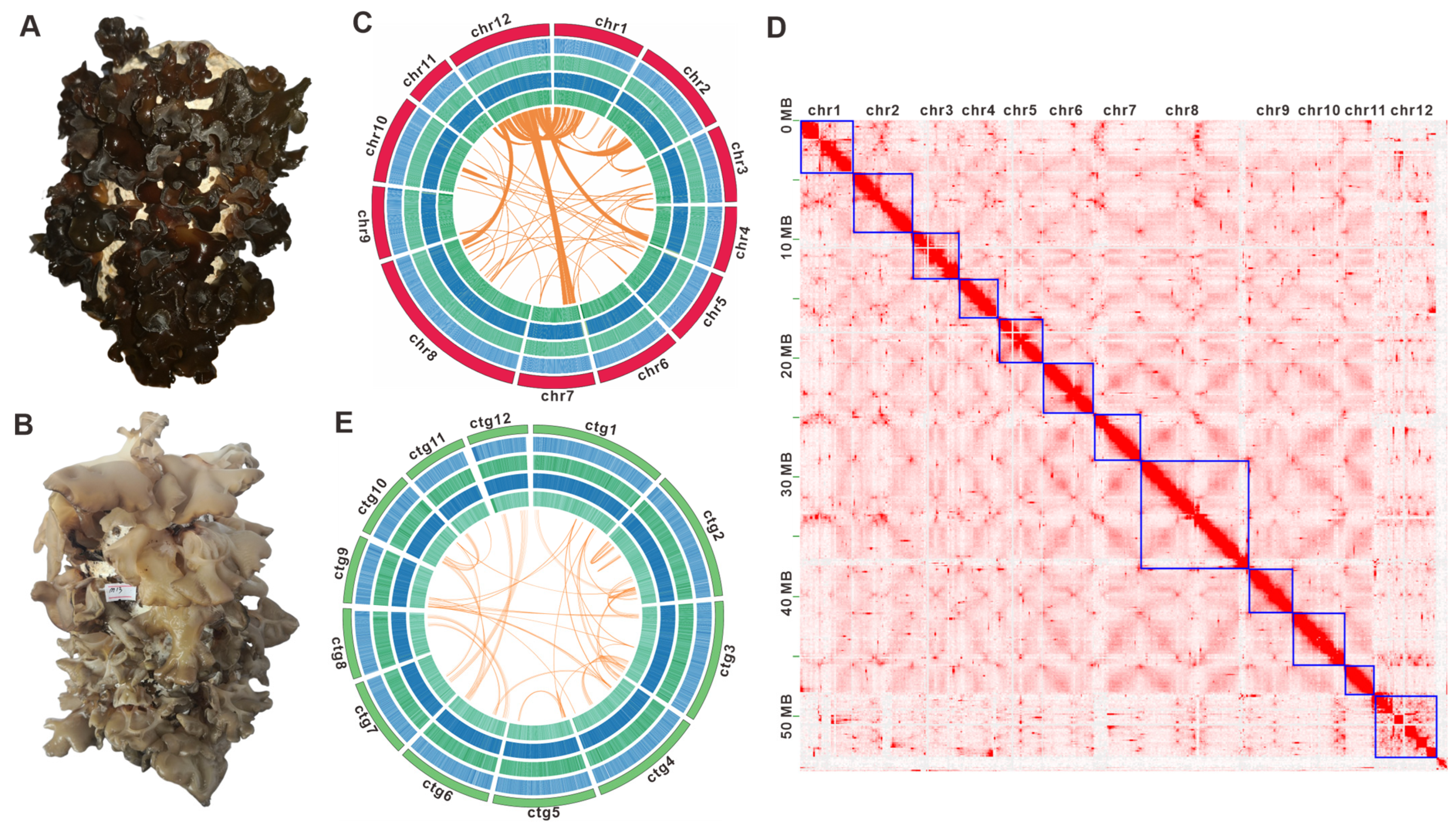
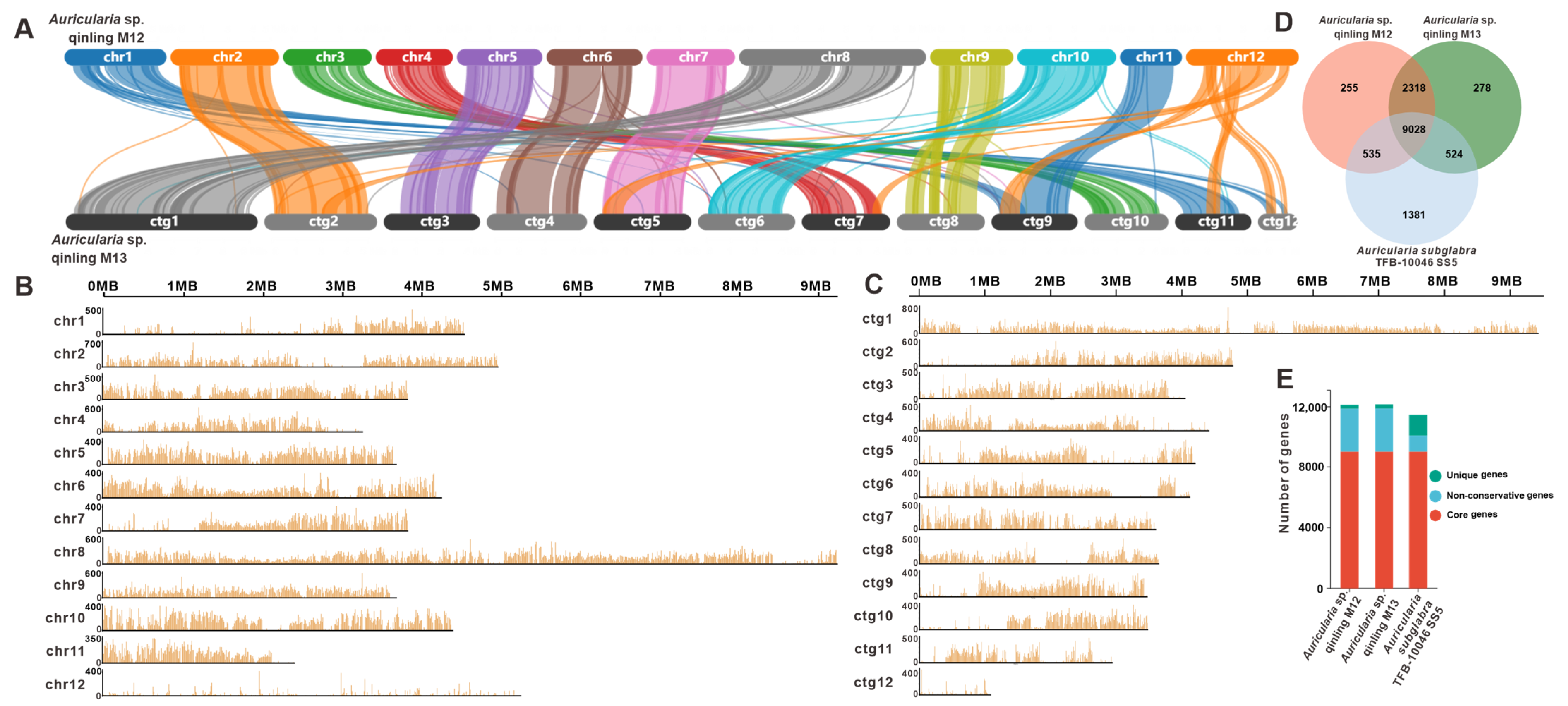
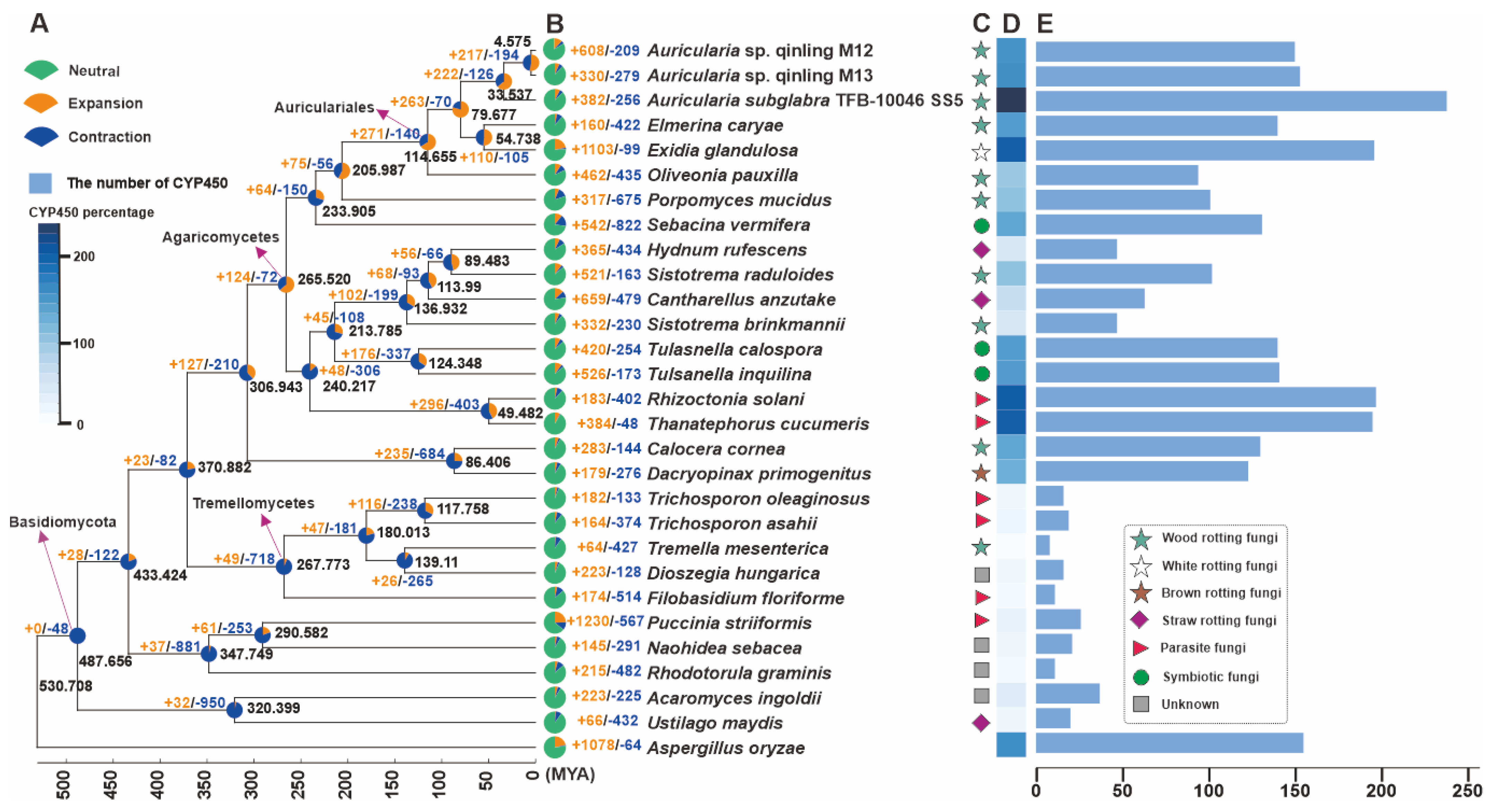
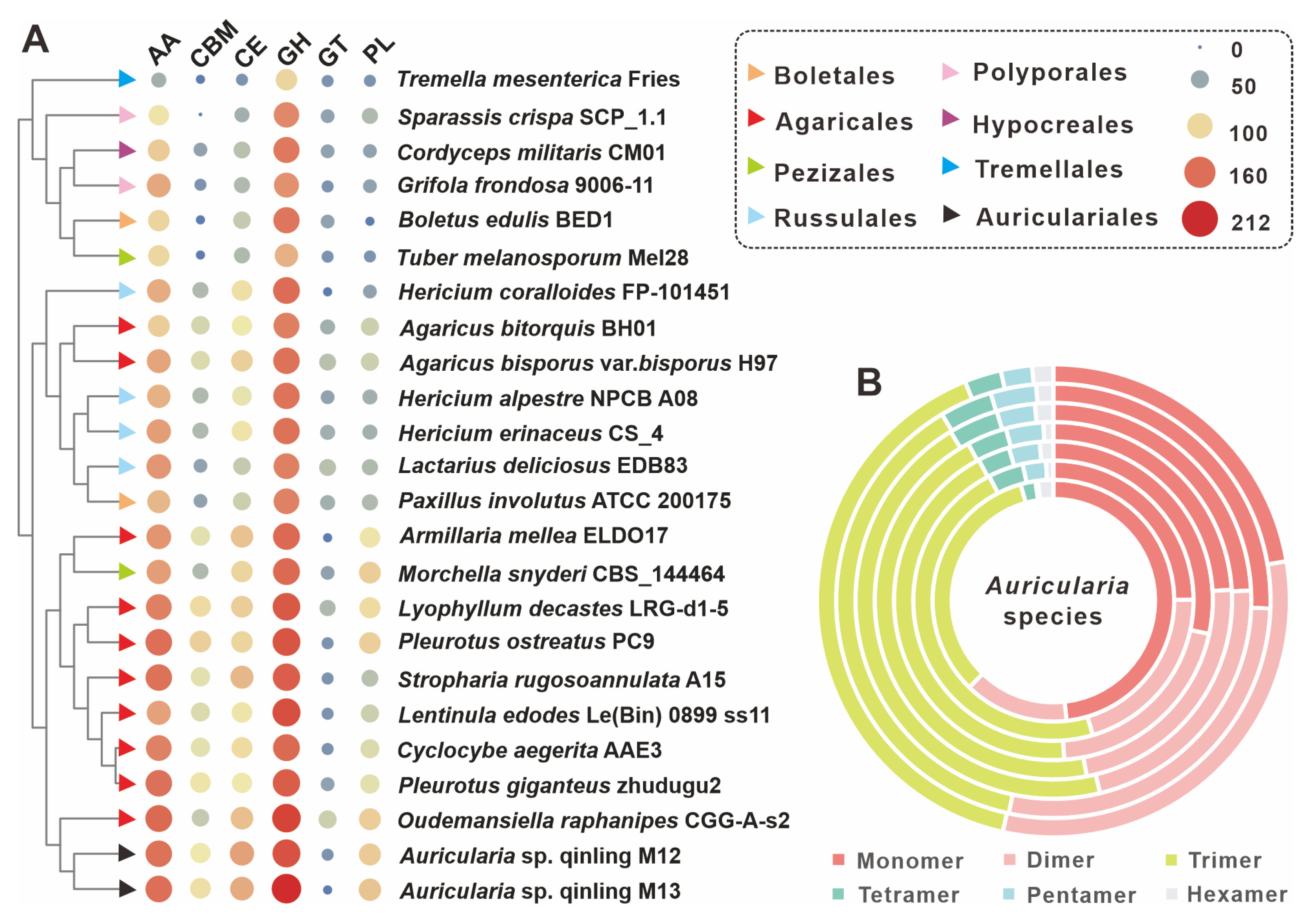

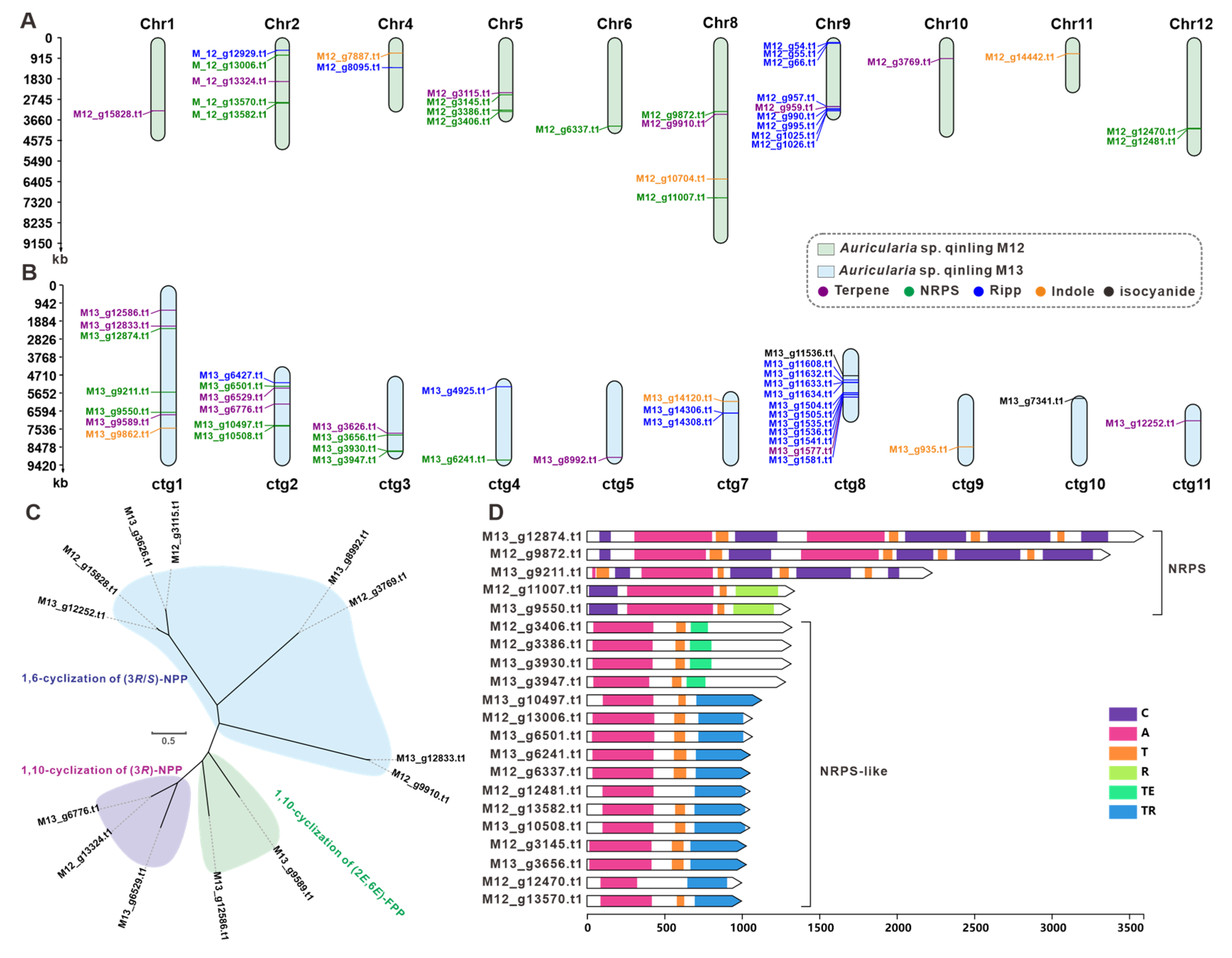
| Entry | Auricularia subglabra TFB-10046 SS-5 | Auricularia heimuer Dai 13782 | Auricularia cornea ACW001-33 | Auricularia heimuer A14-8 | Auricularia cornea CCTCCM 20221287 | Auricularia sp. Qinling M12 | Auricularia sp. Qinling M13 |
|---|---|---|---|---|---|---|---|
| Sequencing technology | Sanger, Roche, Illumina | Illumina, PacBio | Illumina, PacBio | Illumina | Illumina, PacBio | Illumina, Nanopore | Illumina, Nanopore |
| Sequencing depth | 46.6× | 56.0× | 150.0× | 101× | 101.0× | 254.88× | 99.34× |
| Genome size (bp) | 74,920,202 | 49,761,846 | 78,720,327 | 43,569,032 | 73,170,506 | 56,039,961 | 52,096,326 |
| No. of contig | 4688 | 114 | 23 | NA | NA | 13 | 14 |
| No. of scaffold | 1531 | 103 | NA | 535 | 86 | NA | NA |
| No. of chromosome | NA | NA | 13 | NA | NA | 12 | NA |
| Largest length (bp) | 2,214,130 | 2,880,034 | 8,224,108 | 964,551 | 10,960,066 | 7,410,467 | 9,420,553 |
| Contig N50 (bp) | 36 kb | 1,350,668 | 5,662,720 | 269,985 | 5,486,495 | 3,257,518 | 4,342,189 |
| BUSCO completeness (%) | 98.89 | 92.40 | 98.53 | 99.08 | 92.6 | 93.1 | 93.8 |
| GC content (%) | 58.5 | 56.98 | 59.5 | 57.09 | 59.09 | 57.01 | 57.09 |
| No. of protein-coding genes | 23,555 | 16,244 | 18,574 | 14,094 | 19,120 | 17,043 | 16,484 |
| GenBank accession No. | GCA_000265015.1 | GCA_002287115.1 | GCA_030578095.1 | GCA_002092955.1 | GCA_041684135.1 | GCA_037042885.1 | GCA_037042915.1 |
| Reference | Dimitrios Floudas, et al. [20] | Yuan Yuan, et al. [21] | Xiaoxu Ma, et al. [60] | Ming Fang, et al. [61] | Lei Ye, et al. [22] | This study | This study |
| Species | Cluster No. | Location | Start (bp) | End (bp) | Core Gene ID | Core Gene Type |
|---|---|---|---|---|---|---|
| Auricularia sp. Qinling M12 | 1 | Chr1 | 3,253,766 | 3,285,838 | M12_g15828 | Terpene |
| 2 | Chr2 | 518,487 | 600,102 | M12_g12929 | RIPP | |
| 3 | Chr2 | 745,074 | 805,878 | M12_g13006 | NRPS-like | |
| 4 | Chr2 | 1,929,993 | 1,965,389 | M12_g13324 | Terpene | |
| 5 | Chr2 | 2,855,306 | 2,948,006 | M12_g13570 M12_g13582 | NRPS-like | |
| 6 | Chr4 | 658,839 | 687,964 | M12_g7887 | Indole | |
| 7 | Chr4 | 1,291,307 | 1,377,608 | M12_g8093 | RIPP | |
| 8 | Chr5 | 2,436,420 | 2,458,591 | M12_g3115 | Terpene | |
| 9 | Chr5 | 2,505,971 | 2,576,983 | M12_g3145 | NRPS-like | |
| 10 | Chr5 | 3,201,511 | 3,311,118 | M12_g3386 M12_g3406 | NRPS-like | |
| 11 | Chr6 | 3,908,077 | 3,970,050 | M12_g6337 | NRPS-like | |
| 12 | Chr8 | 3,248,971 | 3,320,951 | M12_g9872 | NRPS | |
| 13 | Chr8 | 3,396,683 | 3,431,424 | M12_g9910 | Terpene | |
| 14 | Chr8 | 6,266,874 | 6,298,324 | M12_g10704 | Indole | |
| 15 | Chr8 | 7,112,735 | 7,174,514 | M12_g11007 | NRPS-like | |
| 16 | Chr9 | 174,483 | 296,954 | M12_g54 M12_g55 M12_g66 | RIPP | |
| 17 | Chr9 | 3,029,649 | 3,118,695 | M12_g957 M12_g959 | RIPP Terpene | |
| 18 | Chr9 | 3,131,265 | 3,311,684 | M12_g990 M12_g995 M12_g1025 M12_g1026 | RIPP | |
| 19 | Chr10 | 900,829 | 930,335 | M12_g3769 | Terpene | |
| 20 | Chr11 | 713,973 | 738,997 | M12_g14442 | Indole | |
| 21 | Chr12 | 3,999,942 | 4,092,373 | M12_g12470 M12_g12481 | NRPS-like | |
| Auricularia sp. Qinling M13 | 1 | Ctg1 | 1,263,880 | 1,283,376 | M13_g12586.t1 | Terpene |
| 2 | Ctg1 | 2,089,154 | 2,104,999 | M13_g12833.t1 | Terpene | |
| 3 | Ctg1 | 2,228,179 | 2,274,164 | M13_g12874.t1 | NRPS | |
| 4 | Ctg1 | 5,551,760 | 5,590,378 | M13_g9211.t1 | NRPS | |
| 5 | Ctg1 | 6,615,406 | 6,656,749 | M13_g9550.t1 | NRPS | |
| 6 | Ctg1 | 6,742,657 | 6,761,802 | M13_g9589.t1 | Terpene | |
| 7 | Ctg1 | 7,464,731 | 7,478,093 | M13_g9862.t1 | Indole | |
| 8 | Ctg2 | 785,232 | 846,699 | M13_g6427.t1 | RIPP | |
| 9 | Ctg2 | 1,002,177 | 1,045,104 | M13_g6501.t1 | NRPS-like | |
| 10 | Ctg2 | 1,107,535 | 1,117,659 | M13_g6529.t1 | Terpene | |
| 11 | Ctg2 | 1,938,121 | 1,956,815 | M13_g6776.t1 | Terpene | |
| 12 | Ctg2 | 3,064,296 | 3,134,023 | M13_g10497.t1 M13_g10508.t1 | NRPS-like | |
| 13 | Ctg3 | 2,969,089 | 2,983,152 | M13_g3626.t1 | Terpene | |
| 14 | Ctg3 | 3,043,959 | 3,086,421 | M13_g3656.t1 | NRPS-like | |
| 15 | Ctg3 | 3,883,715 | 3,909,922 | M13_g3930.t1 | NRPS-like | |
| 16 | Ctg3 | 3,923,290 | 3,962,473 | M13_g3947.t1 | NRPS-like | |
| 17 | Ctg4 | 390,206 | 441,980 | M13_g4925.t1 | RIPP | |
| 18 | Ctg4 | 4,226,330 | 4,264,556 | M13_g6241.t1 | NRPS-like | |
| 19 | Ctg6 | 3,984,555 | 4,004,024 | M13_g8992.t1 | Terpene | |
| 20 | Ctg7 | 501,819 | 507,204 | M13_g14120.t1 | Indole | |
| 21 | Ctg7 | 1,105,012 | 1,162,775 | M13_g14306.t1 M13_g14308.t1 | RIPP | |
| 22 | Ctg8 | 1,397,656 | 1,436,913 | M13_g11536.t1 | isocyanide | |
| 23 | Ctg8 | 1,609,754 | 1,660,555 | M13_g11608.t1 | RIPP | |
| 24 | Ctg8 | 1,738,874 | 1,786,304 | M13_g11632.t1 M13_g11633.t1 M13_g11634.t1 | RIPP | |
| 25 | Ctg8 | 2,287,310 | 2,344,999 | M13_g1504.t1 M13_g1505.t1 | RIPP | |
| 26 | Ctg8 | 2,374,982 | 2,441,370 | M13_g1535.t1 M13_g1536.t1 M13_g1541.t1 | RIPP | |
| 27 | Ctg8 | 2,503,216 | 2,557,232 | M13_g1577.t1 M13_g1581.t1 | Terpene RIPP | |
| 28 | Ctg9 | 2,737,821 | 2,759,584 | M13_g935.t1 | Indole | |
| 29 | Ctg10 | 123,365 | 153,057 | M13_g7341.t1 | isocyanide | |
| 30 | Ctg11 | 839,405 | 858,175 | M13_g12252.t1 | Terpene |
Disclaimer/Publisher’s Note: The statements, opinions and data contained in all publications are solely those of the individual author(s) and contributor(s) and not of MDPI and/or the editor(s). MDPI and/or the editor(s) disclaim responsibility for any injury to people or property resulting from any ideas, methods, instructions or products referred to in the content. |
© 2025 by the authors. Licensee MDPI, Basel, Switzerland. This article is an open access article distributed under the terms and conditions of the Creative Commons Attribution (CC BY) license (https://creativecommons.org/licenses/by/4.0/).
Share and Cite
Qi, J.; Kang, S.; Zhang, M.; Qi, S.; Li, Y.; Vadim, K.; Du, S.; Li, M. Genomic Sequencing and Characterization of Two Auricularia Species from the Qinling Region: Insights into Evolutionary Dynamics and Secondary Metabolite Potential. J. Fungi 2025, 11, 395. https://doi.org/10.3390/jof11050395
Qi J, Kang S, Zhang M, Qi S, Li Y, Vadim K, Du S, Li M. Genomic Sequencing and Characterization of Two Auricularia Species from the Qinling Region: Insights into Evolutionary Dynamics and Secondary Metabolite Potential. Journal of Fungi. 2025; 11(5):395. https://doi.org/10.3390/jof11050395
Chicago/Turabian StyleQi, Jianzhao, Shijie Kang, Ming Zhang, Shen Qi, Yulai Li, Khassanov Vadim, Shuangtian Du, and Minglei Li. 2025. "Genomic Sequencing and Characterization of Two Auricularia Species from the Qinling Region: Insights into Evolutionary Dynamics and Secondary Metabolite Potential" Journal of Fungi 11, no. 5: 395. https://doi.org/10.3390/jof11050395
APA StyleQi, J., Kang, S., Zhang, M., Qi, S., Li, Y., Vadim, K., Du, S., & Li, M. (2025). Genomic Sequencing and Characterization of Two Auricularia Species from the Qinling Region: Insights into Evolutionary Dynamics and Secondary Metabolite Potential. Journal of Fungi, 11(5), 395. https://doi.org/10.3390/jof11050395







